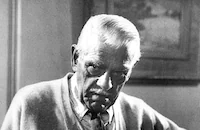The Climax
Brief Synopsis
Cast & Crew
George Waggner
Boris Karloff
Susanna Foster
Turhan Bey
Gale Sondergaard
Thomas Gomez
Film Details
Technical Specs

Synopsis
Ten years after strangling to death his sweetheart, opera singer Marcellina, because she would not give up her career for him, Dr. Frederick Hohner, the resident physician for the Royal Theater, overhears music student Angela Klatt singing a selection from The Magic Voice , the opera that Marcellina was starring in at the time of her death. While Frederick is incensed that Angela is performing music that he feels is "sacred," Count Seebruck, the theater's impresario, is impressed by the young woman's voice and offers her a part in the Royal Theater's next production. Angela is such a great success on opening night that Count Seebruck plans to revive The Magic Voice for her. Hearing this, Frederick lures Angela to his home, under the pretext of a required post-performance throat examination, and hypnotizes the young woman. Under the mad physician's spell, Angela is no longer able to sing, and Frederick gives her an atomizer to carry at all times to remind her of this hypnotic command. Count Seebruck then holds a press conference to announce his plans for Angela and The Magic Voice , but when the young woman attempts to sing an aria, her voice fails her and she rushes off stage in tears. Backstage, Frederick announces that Angela is suffering from nervous tension and suggests that the singer be placed under his care. With work on The Magic Voice in progress, Count Seebruck decides to replace Angela with Jarmila Vadek, the company's less talented prima donna, much to the chagrin of Franz Munzer, Angela's fiancé. While Frederick is at the theater, Franz sneaks into the physician's home and whisks the now-bedridden Angela to safety. Upon the suggestion of his uncle, Carl Bauman, Franz goes to Count Seebruck and requests that Angela be given the chance to perform The Magic Voice before a full company and audience so that she may regain her voice and confidence. When the impresario refuses, Franz and Carl meet with the country's boy-king, who then orders a command performance by Angela. Arriving at the theater on opening night, Angela learns of the king's command, and she seemingly regains her voice when Franz accidentally breaks the atomizer that Frederick has placed in her dressing room. Realizing that his power over Angela is waning, Frederick abducts the young singer and returns her to his home, where he prepares to slit her vocal cords. She is rescued, however, by Franz, Carl and Luise, Frederick's housekeeper. While Frederick is held at gunpoint by Carl, Angela and Franz rush back to the theater just in time for the singer's stage entrance. Though she is hesitant at first, Angela regains her voice and confidence and begins to perform The Magic Voice . Meanwhile, at the physician's home, Frederick knocks Carl unconscious, but the police arrive before he can make his escape. Frederick then rushes upstairs to a hidden room, which he has made into a shrine around Marcellina's embalmed body, and is killed when he accidentally sets the room afire. Back at the theater, Angela successfully concludes her performance, and, amidst thunderous applause, is joined onstage by Franz.

Director

George Waggner
Cast

Boris Karloff
Susanna Foster

Turhan Bey

Gale Sondergaard

Thomas Gomez
June Vincent
George Dolenz

Ludwig Stossel
Jane Farrar
Erno Verebes
Lotte Stein

Scotty Beckett
William Edmunds
Maxwell Hayes
Dorothy Lawrence
Cyril Delevanti
Rex Lease
George Eldredge
Roy Darmour
Polly Bailey
Ernie Adams
Genevieve Bell
Francis Ford
Crew
Bernard B. Brown
William Fox
William Fritzsche
Russell A. Gausman
Joseph Gershenson
Alexander Golitzen
John B. Goodman
Charles S. Gould
W. Howard Greene
Lester Horton
Natalie Kalmus
Gene Lewis
Hal Mohr
Jack Pierce
Russell Schoengarth
Curt Siodmak
Curt Siodmak
Lynn Starling
Lee Sweetland
William Tyroler
George Waggner
George Waggner
Edward Ward
Edward Ward
Ira S. Webb
Vera West
Harold Zweifel

Film Details
Technical Specs

Award Nominations
Best Art Direction
Quotes
Trivia
Notes
According to Hollywood Reporter news items, The Climax was originally intended to be a sequel to Universal's highly successful 1943 release Phantom of the Opera , which featured actors Claude Rains, Susanna Foster and Nelson Eddy, director Arthur Lubin and producer George Waggner. In October 1943, Eddy was replaced in the cast of The Climax by Turhan Bey, and producer Waggner was unable to acquire Rains for the role of "Dr. Frederick Hohner," so Boris Karloff was cast instead, according to Hollywood Reporter. Due to last minute scheduling changes, Lubin then became unavailable, so Waggner assumed both producing and directing duties on the picture. Hollywood Reporter news items include Grace Cunard, Maurice Costello, William Desmond, Stuart Holmes, Eddie Polo, Anne Cornwall, Jack Richardson, Harry Mayo, Gertrude Astor, Helen Gibson, Fred Curtis, Homer Dickinson and Barry Regan in the cast, but their appearance in the released film has not been confirmed.
Art directors John B. Goodman and Alexander Golitzen, along with set decorators Russell A. Gausman and Ira S. Webb, received Academy Award nominations for their interior decoration of The Climax, but lost to Wiard Ihnen and Thomas Little's work on Twentieth Century-Fox's Wilson . Modern sources credit John P. Fulton with special effects. Modern sources also state that Waggner and composer Edward Ward based their musical compositions on themes by Chopin and Schubert. Universal had previously filmed the Edward Locke play under the same title in 1930, starring Jean Hersholt and Kathryn Crawford, directed by Renaud Hoffman (see AFI Catalog of Feature Films, 1921-30; F2.0921).

Miscellaneous Notes
Released in United States Fall October 20, 1944
Released in United States on Video August 6, 1996
Released in United States on Video August 6, 1996
Released in United States Fall October 20, 1944











